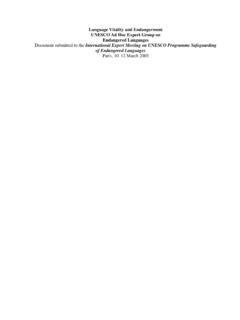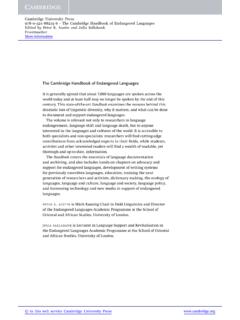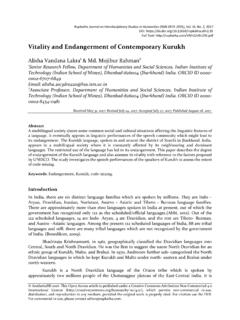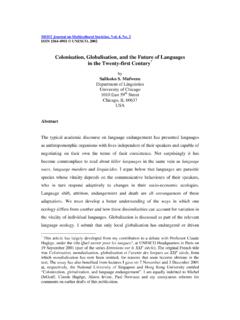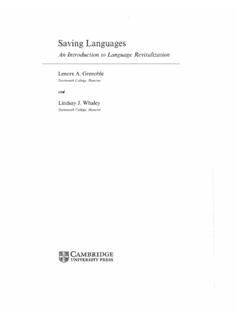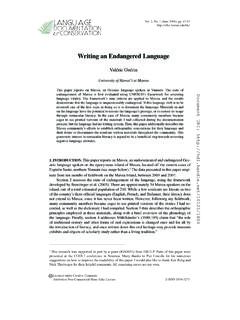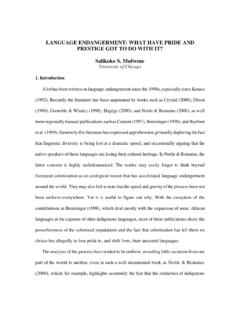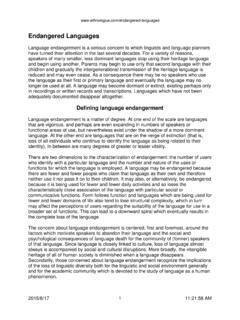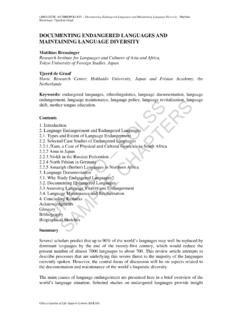Transcription of Endangered Languages: Some Concerns - Environment Portal
1 CommentaryEconomic & Political Weekly EPW august 8, 2009 vol xliv no 3217 Endangered Languages: some ConcernsPapia SenguptaA recent UNESCO report indicates that India has the largest number of Endangered languages in the world. A matter of concern , besides the absolute numbers, is the distribution of these Endangered languages across number of speakers. The languages under threat include both scheduled, non-scheduled as well as official languages of some of the states. Policies for protecting and promoting the entire range of Endangered languages are needed if the linguistic diversity of India is to be preserved.
2 The United Nations Educational, Sci-entific and Cultural Organisation s (UNESCO) Atlas of the World s Lan-guages in Danger (2009), the third in the series, presents a grave picture of the world s languages which are extinct or are on the verge of T he repor t (t he Atlas from here on) provides updated data on about 2,500 Endangered languages, which are classified on the basis of several criteria into five dif ferent levels of v italit y: unsafe, definitely Endangered , severely Endangered , critically Endangered and extinct. It states that out of the approxi-mately 6,000 existing languages in the world, more than 200 have become ex-tinct during the last three generations, 538 are critically Endangered , 502 are se-verely Endangered , 632 are definitely en-dangered and 607 are unsafe.
3 T he A t la s ser ie s i s t he outcome of a n i n i-tiative by UNESCO to promote and preserve the world s linguistic and cultural diversi-ty by safeguarding languages in danger of disappearing. It unanimously adopted the Universal Declaration on Cultural Diver-sity at its 31st session held in October 2001, which recognised the relationship between biodiversity, cultural diversity, and lin-guistic diversity. To generate and dissemi-nate knowledge on Endangered languages and to foster cooperation between local, regional, national and international organi-sations, UNESCO set up the ad hoc expert group on Endangered languages in 2003.
4 This group identified six factors to develop a lan-guage vitality and en-dangerment framework, i e , intergene rational language transmission, absolute number of speakers, proportion of speakers within the total population, shifts in domain of language use, response to new domains and media and materials for lan-guage education and literacy. Three more factors were added later: governmental and institutional language attitudes and policies, community members attitudes towards their own language and type and qualit y of documentation (UNESCO 2009).The Atlas provides fairly detailed infor-mation on the status of Endangered lan-guages in 155 countries.
5 Though India has the largest number of Endangered lan-guages (196), the US reports the largest number of languages (53) that have be-come extinct f rom the 1950s (Table 1). T he latter also has the largest number (71) of languages that are critically Endangered . Need for Linguistic Diversit yLanguage is critical to such basic mental pr o ce s s e s s uc h a s t h i n k i ng, u nde r s t a nd i ng and even dreaming. Arguments for pre-serving linguistic diversity in terms of protecting and promoting languages and providing linguistic rights can be classi-fied into three broad streams, viz, identity-based, justice-based and diversity-based arguments.
6 Identity-Based: language is not simply a tool for communication but is a central and defining feature of identity as all hu-man thoughts are conceptualised through a language and all human values are pro-nounced and perceived through it. It fol-lows that since language is a significant factor in building one s identity, it must be preserved. People identify with the (local) community of speakers of their language , recognise one another as members of the same group on the basis of language , and have a more or less settled desire that the group should survive and flourish into I am thankful to T Ravi Kumar for his comments on an earlier draft of this paper.
7 The usual disclaimer Sengupta is at the Department of Political Science, K irorimal College, Universit y of 1: Countries with the Most Endangered LanguagesCountr y Degree of Vitalit y Unsafe Definitely Severely Critically Extinct1 Total Endangered Endangered Endangered EndangeredIndia 84 62 6 35 9 196US 11 25 32 71 53 192 Brazil 97 17 19 45 12 190 Indonesia 56 30 19 32 10 147 China 41 49 22 23 9 144 Mexico 52 38 33 21 - 144 Russian Federation 21 47 29 20 19 136 Australia 17 13 30 42 6 108 Papua New Guinea 24 15 29 20 10 98 Canada 24 14 16 32 2 88(1) From the : Constructed from data in UNESCO (2009).
8 Commentaryaugust 8, 2009 vol xliv no 32 EPW Economic & Political Weekly18the indefinite future (Patten 2001: 697). Arguing for a policy of language protec-tion, May suggests that language is a con-stitutive and significant factor in one s identity formation and provides their speakers with a sense of individual as well as colle ctive forms of linguistic iden-tity (May 2003: 141). Justice-Based: language is the most im-portant tool of participation in the polity of the state and not being able to speak in the dominant language (or languages) of a state can have a serious impact on an in-dividual s employment, educational and recreational opportunities.
9 This leads to discrimination and injustice. Supporting the policy of official multilingualism as one based on egalitarianism, Patten asserts that the same kinds of valuable institutional spaces and resources that are made available to speakers of one lan-g uage in t he communit y ought to be at t he disposal of speakers of other languages as well (Patten 2001: 710). Unequal linguis-tic endowment in the form of ability to spea k or not spea k t he dom ina nt la ng uage can be the source of interpersonal injus-tice and every citizen should possess the right to mobilise support for a language community or policies that he or she con-siders a collective or public good (Laitin and Reich 2003: 103).
10 Diversity-Based: The last argument for the preservation of linguistic diversity is that this diversity is a value and provides alternatives to choose from different cul-tures representing different systems of meanings and vision of good life as none can claim to have achieved this in totality (Parekh 1995: 205). Further, it has been arg ued that each language is itself a mani-festation of human creativity which has value independent of its use and also that it is a human accomplishment and end in itself (Reaume 2000: 250). Linguistic diversity is, therefore, essen-tial to the human heritage with each and every language embodying the unique cultural and historical wisdom of a people.
